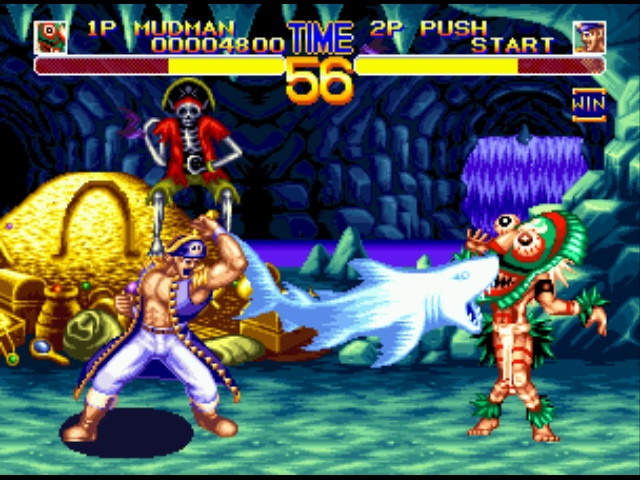Back in 1991, Capcom released its 2D fighting opus Street Fighter II, and in the years that followed a number of competitors brought their own fighting games to market. SNK was by far the most prolific rival, and while some of its games, such as Art of Fighting, innovated upon the formula they were inspired by, developer ADK created World Heroes for the Neo-Geo, a series that was content with completely ripping off from it. Nearly 16 years after the original hit the arcades, all four World Heroes games have been released in a single compilation title, but despite their flawless porting, this series is best forgotten by all but the most hardcore of fans and collectors.
The premise of the World Heroes series is that a wacky scientist lovingly referred to as Dr. Brown Sugar (after Christopher Lloyd's character from Back to the Future) invents a time machine for the purpose of discovering who is the greatest fighter in history. The colorful cast of characters who sign up for this time-travel tournament are ostensibly based on real figures throughout the ages such as Genghis Khan or Jeanne d'Arc, but their tongue-in-cheek designs make them seem more like rejects from Stereotype: The Fighting Game than the historical badasses they're supposed to be. You've got Hanzo and Fuuma, palette-swapped ninjas that are totally not Ryu and Ken; the Nazi robot Brocken that looks like M. Bison but has Dhalsim's stretchy limbs; Muscle Power, a Hulk Hogan clone with Zangief's moveset; Rasputin, a sorcerer who can comically enlarge his hands and feet; Janne, a feminist fencer seeking to bag herself a worthy husband; Kim Dragon, a Korean martial artist and film star; and J. Carn, a Mongolian warlord. Later games in the series follow this trend of absurd character design and include even more over-the-top characters like the pirate Captain Kidd (he can throw ghost sharks!), the demonic football player Johnny Maximum, and the shrieking Pacific Islander witch doctor Mudman.
The original World Heroes features a three-button attack system to perform punches, kicks, and throws. In normal mode, you travel across the world as indicated on a map and battle your opponents in themed stages. Deathmatch mode, the one real innovation that the game has to offer, plays similarly to normal mode but places you in special arenas that often feature electrified walls, spikes, slippery goo, and more. World Heroes 2 is essentially more of the same, though new characters are available, throws can be countered, and projectiles can be deflected. Deathmatch mode has also returned with even wackier stages, though the player health bars have also been combined into a single tug-of-war-style bar.

World Heroes 2 Jet is where things begin to pick up. The first two games laid the foundation (or rather "borrowed" it from elsewhere) but were so absurdly slow even among their peers at the time that playing them was a chore. Jet, much like its name implies, turbo-charges things both by increasing game speed and introducing the ability to perform dashes. It also introduces a new round-robin tournament mode where you battle three different opponents for one round each per match. Unfortunately, for all the steps forward Jet took the series, it falls back a few because it marked the end of the deathmatch mode. World Heroes Perfect, the fourth and final game of the series, changed things up even more by ditching the three-button system of its forefathers and adopting a six-button layout for light, medium, and strong punches and kicks. Notable among other combat changes is the addition of the hero gauge, which lets you perform super moves once it fills.
Jet and Perfect are by far the best-looking games in the collection, though this isn't necessarily saying much. Character sprites and stage backgrounds across all the World Heroes titles were never very high-quality. Controls across the four games are also notoriously clunky and sometimes nonresponsive, making some of the more difficult special moves even harder to execute.
World Heroes Anthology is an interesting retrospective look at the era when 2D fighting games ruled the arcades, but it ultimately holds no real value today for anyone who's not a huge SNK fan or who doesn’t have the patience to get used to the series’ quirky control scheme and characters. Despite the extras that are thrown in, such as the ability to edit character sprite colors and enter training modes directly from the title screen, World Heroes remains a fighting game relic that time has aged terribly and is best left forgotten.